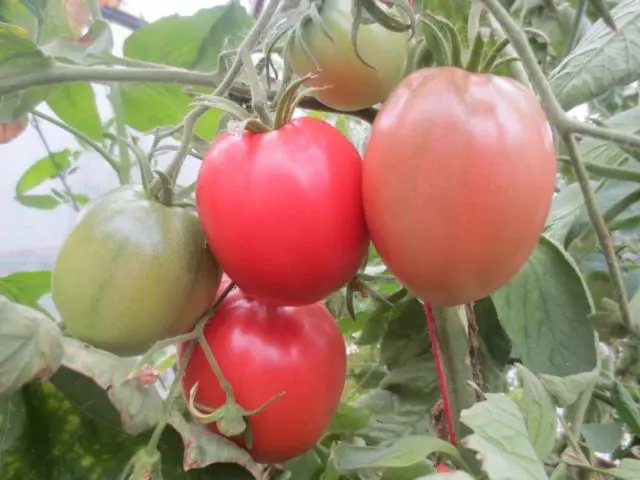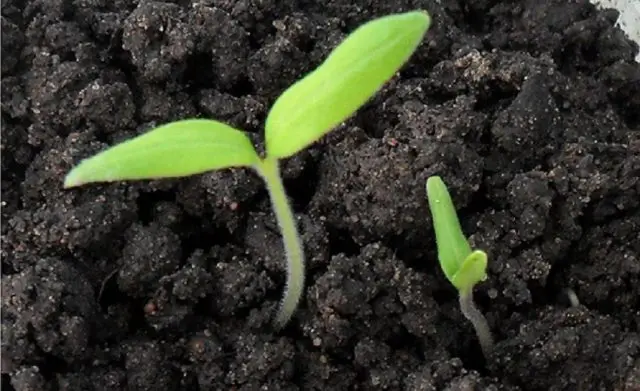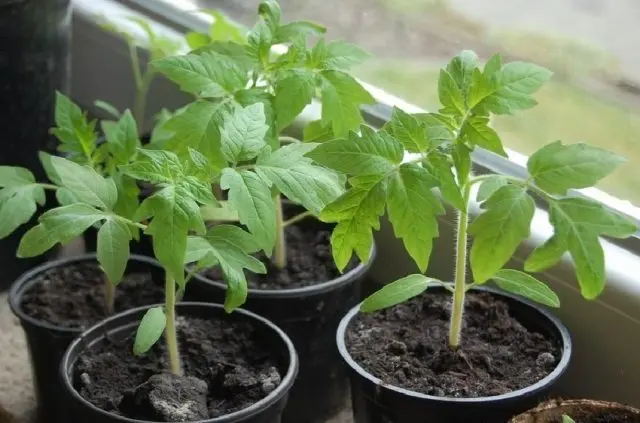Contents
Tomato Larisa is a fairly well-known variety. Its popularity can be easily explained by its quality characteristics and versatility of cultivation. Acquaintance with Larisa tomatoes will help a lot with the description of the variety, reviews of gardeners and photos of plants.
Description of tomato Larisa
A hybrid of Canadian origin refers to the mid-season ripening period. The fruits are ready for harvest 110-115 days after germination. The Federation has included a tomato in the State Register as a variety for open ground and cultivation under a film greenhouse.

The main characteristics of the plant:
- Bush of determinant type. Height in adulthood up to 0,8-1 m. Spreading, leafy stems are strong. The stems themselves are firm and strong.
- The leaves are medium, slightly pubescent, green. The saturation of the color depends on the region of cultivation.
- One bush forms 6-8 brushes, one bunch consists of 5-6 tomatoes. Yellow flowers are collected in inflorescences (brushes). Inflorescences are simple without branching of the axis. Appear on stems through 2-6 internodes. Flowers bloom no more than 2-3 days, but are ready for pollination 2 days before opening. The second brush blooms 1,5-2 weeks after the first. The following – also with an interval of a week.
In addition, vegetable growers note the high endurance of tomato bushes.
Description of fruits
The main goal of vegetable growers is the delicious fruits of the Larisa variety. They are cylindrical, dense, smooth with a characteristic “nose” at the end. Peduncles without articulation.
In immature form, Larisa tomatoes are colored green, ripe – red.
The number of chambers is 2, there are few seeds, they are located close to the skin. The mass of one tomato reaches 100 g. The fruits are distinguished by a high content of dry matter – up to 6%. The palatability of the variety is high. The pulp of Larisa tomatoes is dense, but juicy, sweet and fragrant. The skin is quite dense, does not crack.
They are used fresh for salads and second courses. Suitable for canning as a whole, due to their compact size. Good tomatoes for freezing and pickling.
Characteristics of tomatoes Larisa
Among the main characteristics that vegetable growers are interested in are productivity, disease resistance and exactingness in growing conditions. Tomato hybrid Larisa is distinguished by the following parameters:
- Productivity. If the variety is grown under film cover, then from 1 sq. m at the output is 17-18 kg. In open ground from 1 sq. m collect 5-7 kg of delicious tomatoes Larisa.
- Fruiting begins in mid or late July, depending on the climatic conditions of the region. Since fruit ripening occurs in several stages, within a month the variety pleases the owners with its harvest. Each wave gives a good amount of tomatoes, therefore, with a good agricultural background in the open field, vegetable growers collect up to 9 kg per 1 sq. m of landing area.
- Culture disease resistance. Variety Larisa well resists VTB and Alternaria.
- Ability to transport. The strong skin of the fruit allows you to transport the crop over long distances without damage. At the same time, neither the presentation nor the taste of Larisa tomatoes change at all.
In addition to these characteristics, the variety is resistant to temperature extremes and shows excellent yields even in cool weather.

Evaluation of advantages and disadvantages
The main criteria for choosing a variety for planting are its pros and cons. Tomatoes Larisa are distinguished by such advantages:
- High productivity, regardless of the climatic features of the growing region.
- Fruit set in cloudy, rainy weather and temperature fluctuations.
- Resistance to tomato diseases – Alternaria and tobacco mosaic virus.
- Taste parameters of fruits at a high level. Suitable for children and dietary diet.
- High germination of seed material.
- Excellent transportability and keeping quality of fruits of the variety.
Among the disadvantages of tomato Larisa, vegetable growers note:
- The exactingness of the variety to the careful implementation of the feeding schedule.
- The need for a garter when growing in a greenhouse.
The listed shortcomings are features of the Larisa variety, but they cannot be recognized as a big minus.
Growing rules
Tomatoes are a heat-loving crop. Larisa tomatoes are grown in seedlings. Plants are transplanted to a permanent place with the onset of stable warm weather and sufficient warming of the soil. At the same time, the Larisa variety requires well-cultivated and fertilized soil, adherence to the planting scheme and the implementation of all points of agricultural technology. The main attention should be paid to growing seedlings. The further development of the bush and the yield of the variety depend on the quality of the seedlings.
Seeding for seedlings
The timing of sowing varieties depends on:
- type of cultivation;
- region;
- weather conditions of the current year.
If it is decided to plant the Larisa variety in a film greenhouse, then sowing begins at the end of March, for open ground – at the beginning of April. The lunar calendar with detailed recommendations helps gardeners determine the exact date.
This can only be done when sowing in a heated greenhouse with a good planting area and optimal conditions for seedlings.
Tomato seeds Larisa F1 do not require special preparation. Hybrids are processed by the manufacturer, they also undergo pre-sowing preparation. The variety has a high germination rate, so you should not worry about the number of seedlings at the exit.
The soil for seedlings of the variety can be taken in a special store or prepared independently. Tomato seedlings Larisa is quite unpretentious to the composition of the soil, even tolerates a slight acidity. To prepare the soil mixture, you should take loam, humus and compost in equal proportions, add wood ash. In any case, the soil must be disinfected so as not to expose the seedlings to the risk of infection. It is enough to steam it in the oven or spill it with a strong solution of potassium permanganate (you can replace it with boiling water). Prevention is necessary not only for prepared soil, but also for purchased soil. Experienced vegetable growers advise to additionally shed the grooves for the seeds of the variety with a solution of copper sulphate (3 tsp per 1 liters of water) to prevent infection of tomato seedlings with a black leg.
The container is taken as convenient as possible – planting boxes, containers, peat pots, plastic boxes. The containers are disinfected and filled with wet soil mixture.

Grooves can be made in the soil, or you can simply spread the seeds of the variety on the surface and sprinkle with earth. Then moisten, cover the containers with glass or film until sprouts appear. The germination temperature is + 25-30 ° C, so it is recommended to place a container with Larisa seeds near the heating.
While waiting for sprouts, it is necessary to monitor the humidity inside the greenhouse. If the earth is dry, moisten it with a spray gun, if there is strong condensate, remove the glass (film) for a while.
As soon as shoots appear, the container with seedlings of Larisa variety tomatoes is moved to a place with good lighting. The shelter is not immediately removed, gradually opening every day to accustom the seedlings to the ambient temperature.
It is important to carefully adhere to the rules for watering seedlings of tomato varieties Larisa. It is unacceptable to fill seedlings or overdry. The first top dressing is done 2-3 weeks after germination, then the interval between top dressing is 7 days. It is best to take ready-made fertilizer for seedlings.
It is necessary to dive seedlings of Larisa tomatoes at the age of 7-10 days, if the seeds are sown in a common box. Those that were originally planted in a separate container dive at the age of 2-3 weeks.

Transplanting tomatoes to a permanent place is carried out when the seedlings are 1,5 months old. For 2 weeks, the gradual hardening of seedlings begins.
Seedling transplant
April for greenhouses and the end of May or the beginning of June for open ground are considered the optimal dates for transplanting the Larisa variety. Wells 30 cm deep, density per 1 sq. m is 4-5 plants (open ground) and 3 plants in greenhouses. It is important to maintain a distance between plants of 35 cm, leave a row spacing of at least 70 cm.
The central stalk of tomatoes is deepened by 2 cm so that additional roots form on it. The earth around is compacted, the plants are watered.

Care of tomatoes
The main points for the care of Larisa tomatoes:
- Watering. Basic watering – 1 time in 7 days. Additional – as needed, especially in dry times. The rate of water consumption per bush of tomatoes is 3-5 liters. In the greenhouse you need to monitor the humidity. For the Larisa variety, watering should be done early in the morning and only under the root.
- Top dressing. Larisa variety tomatoes begin to be fed 3 weeks after transplantation. The first time liquid mullein (0,5 l) + nitrophoska (1 tbsp. l) + 10 l of water. For one bush of tomatoes you need 0,5 liters of solution. The second – after 14 days, infusion of chicken manure with the addition of 1 tsp. potassium sulfate and 1 tbsp. l. superphosphate. Consumption – 0,5 liters per tomato. The third – during the period of fruit setting. The composition of the solution is potassium humate (1 tbsp), nitrophoska (1 tbsp) and water (10 l). Norm per 1 sq. m not more than 1 liter. All compounds can be replaced with mineral complexes.
- After flowering, start pinching. Stepchildren should not be allowed to grow more than 4 cm.
- To improve the ventilation of the bushes of the Larisa variety and support the shoots with fruits, it is necessary to tie them to supports.
Harvesting is carried out gradually, collecting ripe fruits.
Conclusion
Tomato Larisa is a very productive and unpretentious variety. If you follow the recommendations for its cultivation, then getting a high yield will not be at all difficult.









